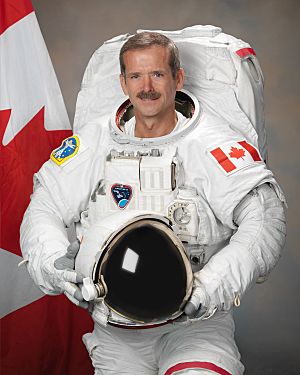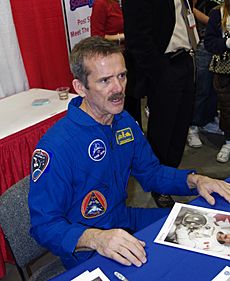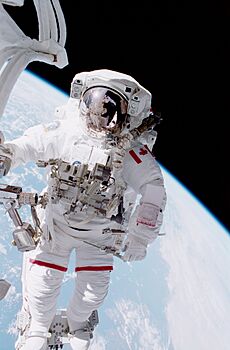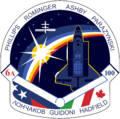Chris Hadfield facts for kids
Quick facts for kids
Chris Hadfield
OC OOnt MSC CD
|
|
|---|---|

Hadfield in July 2011
|
|
| Born |
Chris Austin Hadfield
August 29, 1959 |
| Awards |
|
| Space career | |
| CSA astronaut | |
|
Time in space
|
165 days, 16 hours, 18 minutes |
| Selection | 1992 CSA Group NASA Group 14 (1992) |
|
Total EVAs
|
2 |
|
Total EVA time
|
14 hours, 50 minutes |
| Missions |
|
|
Mission insignia
|
|
| Retirement | July 3, 2013 |
| Military career | |
| Allegiance | |
| Service/ |
|
| Years of service | 1978–2003 |
| Rank | Colonel |
Chris Austin Hadfield (born August 29, 1959) is a famous Canadian astronaut, engineer, and pilot. He is also a musician and writer. Chris Hadfield was the first Canadian to walk in space. He flew on two Space Shuttle missions and was even the commander of the International Space Station (ISS). Before becoming an astronaut, he was a fighter pilot in the Canadian Armed Forces for 25 years.
Chris Hadfield was inspired to become an astronaut when he was a child. He watched the first Moon landing by Apollo 11 on TV. He went to high school in Oakville, Ontario and Milton, Ontario. He earned his glider pilot licence as a member of the Royal Canadian Air Cadets. After joining the Canadian Armed Forces, he studied engineering at the Royal Military College of Canada. Hadfield learned to fly many types of aircraft and became a test pilot. He even flew experimental planes. He also earned a master's degree in aviation systems.
In 1992, Hadfield was chosen for the Canadian astronaut program. His first space flight was in November 1995 on STS-74. On this mission, he visited the Russian space station Mir. He flew again in April 2001 on STS-100. During this mission, he visited the ISS and walked in space to help install Canadarm2. In December 2012, he flew for a third time on Soyuz TMA-07M to join Expedition 34 on the ISS.
When Expedition 34 ended in March 2013, Hadfield became the commander of the ISS. He was in charge of five astronauts. He helped run many science experiments about how low gravity affects humans. During this mission, he shared his life on the space station. He took pictures of Earth and posted them on social media. He also became popular by playing the guitar on the ISS. Hadfield returned to Earth in May 2013. He retired soon after, ending his 35-year career as a pilot and astronaut. He has written five books, including his autobiography, An Astronaut's Guide to Life on Earth.
Contents
Early Life and Family
Chris Hadfield was born in Sarnia, Ontario. His parents are Roger and Eleanor Hadfield. They live in Milton, Ontario. Chris grew up on a corn farm in southern Ontario. He was a member of a Wolf Cub Pack. He became interested in flying at a young age. He wanted to be an astronaut at age nine after seeing the Apollo 11 Moon landing. On December 23, 1981, he married his high-school girlfriend, Helene Walter. They have three children: Kyle, Evan, and Kristin. Before becoming a test pilot, Hadfield was a ski instructor.
Hadfield is a big fan of the Toronto Maple Leafs hockey team. He even wore a Leafs jersey under his spacesuit when he returned from space in May 2013. He sang the Canadian National Anthem at a Toronto Maple Leafs game in 2014. In November 2022, he spoke to the Canada men's national soccer team before their first game in the 2022 FIFA World Cup.
Education and Military Career
Hadfield went to White Oaks Secondary School and then graduated from Milton District High School in 1977. As a member of the Royal Canadian Air Cadets, he earned a glider pilot scholarship at 15. He got a powered pilot scholarship at 16. In 1978, he joined the Canadian Armed Forces. He studied at Royal Roads Military College and the Royal Military College of Canada. He earned a degree in mechanical engineering in 1982. He also did research at the University of Waterloo.
In 1983, he was the top graduate from Basic Jet Training. He then trained as a tactical fighter pilot. He flew Canadair CF-116 Freedom Fighter and McDonnell Douglas CF-18 Hornet jets. He flew CF-18 Hornets for NORAD, intercepting planes. He was the first CF-18 pilot to intercept a Soviet bomber in the Canadian Arctic.
In the late 1980s, Hadfield attended the US Air Force Test Pilot School. He also worked with the United States Navy. He tested aircraft like the McDonnell Douglas F/A-18 Hornet. He also did research with NASA. He flew over 70 different types of aircraft in his career. In May 1992, he earned a master's degree in aviation systems.
Astronaut Career
In June 1992, Chris Hadfield was chosen as one of four new Canadian astronauts. Over 5,000 people applied. Three of these four astronauts, including Hadfield, have flown in space. Hadfield was sent to the NASA Johnson Space Center in Texas. He worked on technical and safety issues for Space Shuttle operations. He also helped develop the "glass shuttle cockpit."
Hadfield was NASA's chief CAPCOM. This means he was the voice of mission control talking to astronauts in space. He did this for 25 Space Shuttle missions. From 1996 to 2000, he was the chief astronaut for the CSA.
From 2001 to 2003, he was the director of operations for NASA in Star City, Russia. He helped coordinate all International Space Station crew activities in Russia. He also trained to be a flight engineer cosmonaut in the Soyuz TMA spacecraft. He learned to do spacewalks in the Russian Orlan spacesuit.
Hadfield retired from the Canadian Armed Forces in 2003. He then became a civilian CSA astronaut. From 2003 to 2006, he was chief of robotics for the NASA Astronaut Office. From 2006 to 2008, he was chief of International Space Station Operations. In 2010, NASA announced that Hadfield would be the first Canadian commander of the International Space Station. He led Expedition 35 after launching on December 19, 2012. His spacecraft docked with the station on December 21. He stayed on the station for five months. He returned to Earth on May 13, 2013.
In June 2013, Hadfield announced his retirement from the Canadian Space Agency. He said he would move back to Canada. He had lived in the United States for his career since the 1980s. He plans to pursue private interests outside of government work. Hadfield is excited about future missions to Mars. He said he would be honored to be the first to visit Mars, even if it were a one-way trip.
STS-74 Mission
Hadfield was a mission specialist on STS-74 in November 1995. This was NASA's second Space Shuttle mission to meet and dock with the Russian Space Station Mir. The crew of Space Shuttle Atlantis attached a large docking module to Mir. They also transferred over 1,000 kg of food, water, and supplies. Hadfield was the first Canadian to operate the Canadarm in space. He was also the only Canadian to ever board Mir.
STS-100 Mission
In April 2001, Hadfield was a mission specialist on STS-100. This mission helped build the International Space Station (ISS). The crew of Space Shuttle Endeavour delivered and installed Canadarm2. This is a new Canadian-built robotic arm. They also brought the Italian-made resupply module Raffaello. During the 11-day flight, Hadfield performed two spacewalks. This made him the first Canadian to ever leave a spacecraft and float freely in space. During his first spacewalk, he had eye irritation. This was from the anti-fog solution in his spacesuit visor. It temporarily blinded him. In total, Hadfield spent 14 hours and 50 minutes outside. He traveled 10 times around the world during his spacewalks.
International Space Station Commander
On December 19, 2012, Hadfield launched on the Soyuz TMA-07M flight. He stayed on the ISS for a long time as part of Expedition 35. He arrived at the station two days later. He became the first Canadian to command the ISS in March 2013. On May 12, 2013, he handed over command of the ISS. He returned home on the Soyuz spacecraft on May 13. He gained a lot of media attention during his time on the ISS. He ended his time on the station by singing "Space Oddity" by David Bowie.
Music and Books
While on Expedition 35, Hadfield recorded music for an album. He used a guitar that was already on the ISS. The first song recorded in space, "Jewel in the Night," was released on YouTube on Christmas Eve 2012.
He worked with Ed Robertson of Barenaked Ladies and the Wexford Gleeks. Their song, Is Somebody Singing? (also called I.S.S.), was released online in February 2013. Hadfield sang this song with singers across Canada for the Music Monday program. He has also sung on his brother Dave Hadfield's albums. They sang the "Canada Song" together, released on YouTube on Canada Day 2014.
On May 12, 2013, Hadfield released a music video of "Space Oddity" by David Bowie. He recorded it on the ISS. As of July 2025, the video has over 55 million views on YouTube.
In October 2015, Hadfield released Space Sessions: Songs From a Tin Can. This album included songs he recorded on the International Space Station.
Hadfield's autobiography, An Astronaut's Guide to Life on Earth, was published in 2013. It talks about his professional life and how he prepared to command Expedition 35. The book was a New York Times bestseller. It was also the bestselling book in Canada about a Canadian subject. In 2021, Hadfield released his first novel, The Apollo Murders. It is a thriller set during the Cold War. A sequel, The Defector, was released in 2023.
Post-Retirement Activities
After retiring, Hadfield was interviewed by Maclean's magazine in October 2013. He also wrote an article for Wired magazine in December 2013. In the article, he shared his thoughts about his time on the International Space Station.
On October 8, 2013, the University of Waterloo announced that Hadfield would join the university as a professor. He started in the Fall of 2014 for a three-year term. He helps teach and advise in aviation programs. He also helps with research on astronaut health.
In 2017, Hadfield hosted the BBC show Astronauts: Do You Have What It Takes?. In this show, 12 contestants competed to be recommended as future astronaut candidates. The challenges were like real tests used by space agencies.
Hadfield also hosted a web series about space exploration on MasterClass. In February 2021, Virgin Galactic announced that Hadfield joined their Space Advisory Board. He helps advise the company as it works to open space for everyone.
Awards and Recognition
Chris Hadfield has received many awards and special honors. He was appointed to the Order of Ontario in 1996. He became an Officer of the Order of Canada in 2014. He received the Vanier Award in 2001 and the NASA Exceptional Service Medal in 2002. He also received the Queen's Golden Jubilee Medal in 2002 and the Queen's Diamond Jubilee Medal in 2012. He is the only Canadian to receive both a military and civilian Meritorious Service Cross.
In 1988, Hadfield received the Liethen-Tittle Award as the top pilot graduate of the USAF Test Pilot School. He was named US Navy Test Pilot of the Year in 1991. He was inducted into Canada's Canadian Aviation Hall of Fame in 2005. The Royal Military College gave him an honorary Doctorate of Engineering in 1996. Trent University gave him an honorary Doctorate of Laws in 1999.
Hadfield was honored on Royal Canadian Mint silver and gold coins. These coins celebrated his spacewalk to install Canadarm2 in 2001. In Sarnia, the city airport was renamed Sarnia Chris Hadfield Airport in 1997. There are also two public schools named after him. The asteroid 14143 Hadfield is named after him. In 2005, the Royal Canadian Air Cadets 820 Milton Blue Thunder Squadron was renamed the 820 Chris Hadfield Squadron. This was in honor of Hadfield, who was a cadet there. The Town of Milton also named a park and street after him. In 2014, his name was added to the Wall of Honour at the Royal Military College of Canada. In 2020, a new species of bee, Andrena hadfieldi, was named after him.
When he took command of the International Space Station, Elizabeth II, the Queen of Canada, sent him a personal message of congratulations. Charles III met with Hadfield at Buckingham Palace in February 2023. They discussed how to make space travel more sustainable.
Music Albums
| Title | Album details | Peak chart positions | Certifications |
|---|---|---|---|
| CAN |
|||
| Space Sessions: Songs From A Tin Can |
|
10 |
Guest Songs
| Title | Year | Other artist(s) | Album |
|---|---|---|---|
| "So Easy" | 2014 | Emm Gryner | Torrential |
| "Re-Entry" | 2021 | TWRP | New & Improved |
Hadfield also sings and plays guitar for the astronaut band Max Q.
Images for kids
See also
 In Spanish: Chris Hadfield para niños
In Spanish: Chris Hadfield para niños









